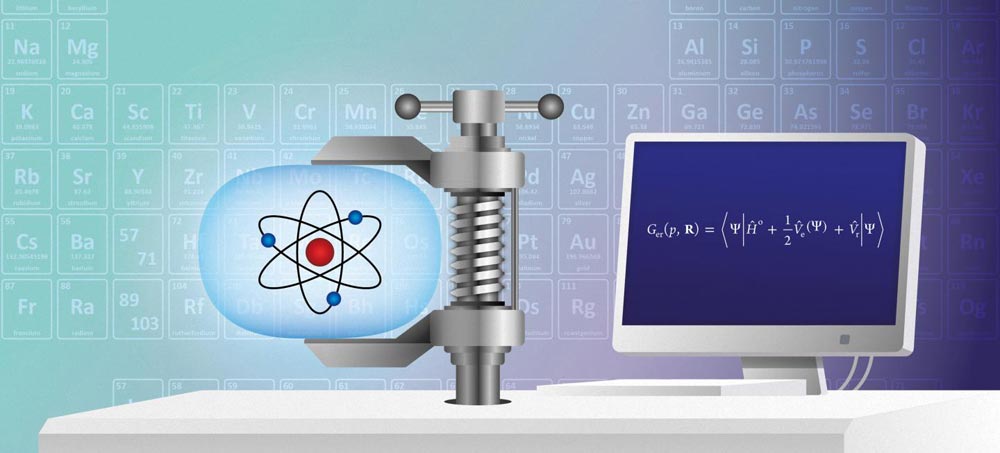

At high pressure, extremely fascinating chemical structures with unusual qualities can arise, and reactions that are impossible under normal conditions can occur. In the dimension of pressure there is an unbelievable number of new combinations of atoms to investigate.
Credit: Yen Strandqvist/Chalmers University of Technology
The study maps how both the electronegativity and the electron configuration of elements change under pressure. These findings offer materials researchers an entirely new set of tools. Primarily, it means it is now possible to make quick predictions about how certain elements will behave at different pressures, without requiring experimental testing or computationally expensive quantum mechanical calculations.
“Currently, searching for those interesting compounds which appear at high pressure requires a large investment of time and resources, both computationally and experimentally. As a consequence, only a tiny fraction of all possible compounds has been investigated. The work we are presenting can act as a guide to help explain what to look for and which compounds to expect when materials are placed under high pressure,” says Martin Rahm, Assistant Professor in Chemistry at Chalmers, who led the study.
At high pressures the properties of atoms can change radically. The new study shows how the electron configuration and electronegativity of atoms change as pressure increases. Electron configuration is fundamental to the structure of the periodic table. It determines which group in the system different elements belong to.
Electronegativity is also a central concept to chemistry and can be viewed as a third dimension of the periodic table. It indicates how strongly different atoms attract electrons. Together, electron configuration and electronegativity are important for understanding how atoms react with one another to form different substances. At high pressure, atoms which normally do not combine can create new, never before seen compounds with unique properties.
Such materials can inspire researchers to try other methods for creating them under more normal conditions, and give us new insight into how our world works.
“At high pressure, extremely fascinating chemical structures with unusual qualities can arise, and reactions that are impossible under normal conditions can occur. A lot of what we as chemists know about elements' properties under ambient conditions simply doesn't hold true any longer. You can basically take a lot of your chemistry education and throw it out the window! In the dimension of pressure there is an unbelievable number of new combinations of atoms to investigate” says Martin Rahm.
A well-known example of what can happen at high pressure is how diamonds can be formed from graphite. Another example is polymerisation of nitrogen gas, where nitrogen atoms are forced together to bond in a three-dimensional network. These two high-pressure materials are very unlike one another.
Whereas carbon retains its diamond structure, polymerised nitrogen is unstable and reverts back to gas form when the pressure is released. If the polymer structure of nitrogen could be maintained at normal pressures, it would without doubt be the most energy dense chemical compound on Earth.
Currently, several research groups use high pressures to create superconductors – materials which can conduct electricity without resistance. Some of these high-pressure superconductors function close to room temperature. If such a material could be made to work at normal pressure, it would be revolutionary, enabling, for example, lossless power transfer and cheaper magnetic levitation.
“First and foremost, our study offers exciting possibilities for suggesting new experiments that can improve our understanding of the elements. Even if many materials resulting from such experiments prove unstable at normal pressure, they can give us insights into which properties and phenomena are possible. The steps thereafter will be to find other ways to reach the same results,” says Martin Rahm.
Read the article 'Squeezing All Elements in the Periodic Table: Electron Configuration and Electronegativity of the Atoms under Compression' in the Journal of the American Chemistry Society.
High pressure research:
The research has theoretically predicted how the nature of 93 of the 118 elements of the periodic table changes as pressure increases from 0 pascals up to 300 gigapascals (GPa). 1 GPa is about 10,000 times the pressure of the Earth's surface. 360 GPa corresponds to the extremely high pressure found near the Earth's core. Technology to recreate this pressure exists in different laboratories, for example, using diamond anvil cells or shock experiments.
“The pressure that we are used to on Earth's surface is actually rather uncommon, seen from a larger perspective. In addition to facilitating for high pressure material synthesis on Earth, our work can also enable a better understanding of processes occurring on other planets and moons. For example, in the largest sea in the solar system, many miles under the surface of Jupiter's moon Ganymede. Or inside the giant planets, where the pressure is enormous,” says Martin Rahm.
The work was done using a mathematical model, in which each atom was placed in the middle of a spherical cavity. The effect of increased pressure was simulated through gradual reduction of the volume of the sphere. The physical properties of the atoms in different stages of compression could then be calculated using quantum mechanics.
###
More information:
At high pressure, atoms and molecules come closer together, and take on different atomic and electronic structures. A consequence of this is that materials that are usually semi-conductors or insulators can transform into metals.
Only some materials that form at high pressure retain their structure and properties when returned to ambient pressure.
The research was done together with colleagues Roberto Cammi, University of Parma, as well as Neil Ashcroft and Nobel prize winner Roald Hoffmann, both at Cornell University.
Contact:
Martin Rahm
Assistant Professor, Chemistry and Chemical Engineering
Chalmers University of Technology, Sweden
martin.rahm@chalmers.se
+46 31 772 30 50
Homepage of Rahmlab, Martin Rahm's research group












